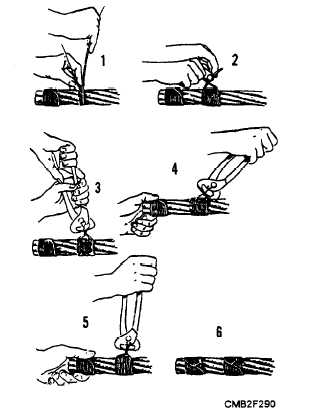FLEET ANGLE. - The fleet angle is formed by running wire rope between a sheave and a hoist drum whose axles are parallel to each other (fig. 6-48). Too large a fleet angle can cause the wire rope to climb the flange of the sheave and can also cause the wire rope to climb over itself on the hoist drum.
SIZES OF SHEAVES. - The diameter of a sheave should never be less than 20 times the diameter of the wire rope. An exception is 6 x 37 wire for which a smaller sheave can be used, because it is more flexible.
REVERSE BENDS. - Whenever possible, drums, sheaves, and blocks used with wire rope should be placed to avoid reverse or S-shaped bends. Reverse bends cause the individual wires or strands to shift too much and increase wear and fatigue. For 'a reverse bend, the drums and blocks affecting the reversal should be of a larger diameter than ordinarily used and should be spaced as far apart as possible.
SEIZING AND CUTTING. - The makes of wire rope are careful to lay each wire in the strand and each strand in the rope under uniform tension. If the ends of the rope are not secured properly, the original balance of tension will be disturbed. Maximum service is not obtainable because some strands can carry a greater portion of the load than others can. Before cutting steel wire rope, place seizing on each side of the point where the rope is to be cut.

Figure 6-48. - Fleet angle relationship.

Figure 6-49. - Seizing wire rope.
A rule of thumb for determining the size, number, and distance between seizing is as follows:
The number of seizing to be applied equals approximately three times the diameter of the rope.
Example: 3 x 3/4-inch-diameter rope = 2 1/4 inches. Round up to the next higher whole number and use three seizing.
The width of each seizing should be 1 to 1 1/2 times as long as the diameter of the rope.
Example: 1 x 3/4-inch-diameter rope = 3/4 inch. Use a 1-inch width of seizing.
The seizing should be spaced a distance equal to twice the diameter of the wire rope. Example: 2 x 3/4-inch-diameter rope = 1 1/2 inches. Space the seizing 2 inches apart.
A common method used to make a temporary wire rope seizing is as follows (fig. 6-49):
Wind the seizing wire uniformly, using tension on the wire. After making the required number of turns, as shown in step 1, twist the ends of the wires counterclockwise by hand, so the twisted portion of the wires is near the middle of the seizing, as shown in step 2.
Continue Reading